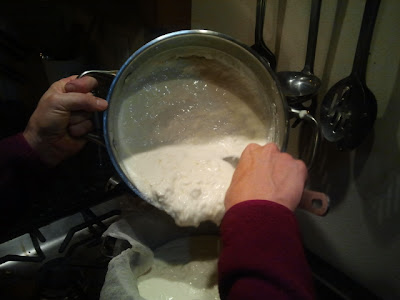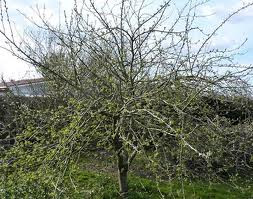Authentic natural Greek style yogurt can be made for little more than the cost of the milk itself (currently a $2.60 gallon of whole milk becomes 2 quarts of Greek yogurt).
Making yogurt is a multi-step process that seems time consuming and confusing at first, but it's really very simple, and can be done with a few inexpensive tools you probably already own.
(Pictures at the end of the post)
Preparation and cooking time: less than one hour.
Processing time: 24 - 36 hours.
Ingredients:
- Milk: anything from skim to whole milk will work, but whole milk will produce a slightly thicker, creamier yogurt. Embrace the fat, I say!
- Yogurt starter: Any plain or flavored yogurt that contains "Live and Active" cultures (it will say this on the label). The starter imparts its flavor to the finished product, so choose one that you like. My favorite starter is Mountain High Plain; Dannon and Activia brands also should work. My In-Laws use Fage greek yogurt as a starter. You can also purchase powdered yogurt culture packets from the health food store.
Equipment:
- Stainless steel saucepan or pot with lid.
- Kitchen thermometer. My favorite has an increasing temperature alarm as well as a decreasing temperature alarm, but any accurate thermometer will do.
- Ice chest or cooler: large enough to easily fit your saucepan or pot inside.
- Colander or strainer that fits snugly inside a large pot or bowl
- Cheesecloth
Step 1: Measure milk into a stainless steel saucepan or pot. Use twice as much milk as the volume of greek yogurt you wish to produce. Therefore, if you wish to end up with 1 Quart of thick greek yogurt, start with 2 Quarts of milk.
Step 2: Cover pot with a lid. Heat on medium to medium high heat until milk reaches 180 degrees F.* Stirring is not required. Stay in the kitchen and monitor the temperature every few minutes if your thermometer doesn't have an upper limit alarm. Once the temperature gets above 140 F it goes fast, so stay close. You do not want the milk to boil!
Step 3: Remove saucepan from the stove onto a heat resistant surface or cooling rack. Remove lid. Allow milk to cool to 120 degrees F. This will take 30 minutes or so. If you're in a hurry, place the saucepan in a cold water bath in the sink and stir to speed up this process.
Step 4: Add yogurt starter to cooled milk at a rate of 2 Tbsp starter to 1 Quart of milk (for powdered starter follow label instructions). If making more than two quarts, you may stir gently to distribute starter throughout the milk, but it isn't necessary for small batches. Yogurt culture is active between 90 and 120 degrees, so don't worry if your milk has cooled somewhat below 120. The point is that you don't want to put the starter in milk warmer than 120 or you will kill the starter.
Step 5: Add up to 6 inches of hot tap water to the cooler. It's best if the water isn't too much above 120 degrees. If your water heater is on steroids, test the temperature of the water to make sure it isn't above 130 degrees. Place the cooler somewhere it won't be jostled or moved while the yogurt is fermenting.
Step 6: Place saucepan into the cooler, making sure that the water is not in danger of flowing into the milk in the saucepan. Water on the outside of the pan should be about the same level as the milk inside the pan. It's ok if the pan floats. If your saucepan won't fit in the cooler but you have another metal or glass container that does, it's fine to transfer the milk. Do not cover the milk.
Step 7: Close the lid of the cooler and set your alarm to come back in 24 hours.
After 24 hours your milk will have been transformed into yogurt! There may be some separation of the curd from the whey. It will have a sharp acidic smell and taste that is likely stronger than you are accustomed to from storebought yogurt. If you don't like it that strong, try checking after 12 or 18 hours of fermentation.
Fresh, warm yogurt is still rather runny. You may eat/drink it at this point, or refrigerate to thicken, or you may strain out the whey to turn it into thick Greek style yogurt.
Step 8: Place colander/strainer inside a large deep bowl or pot so that it is suspended 4 or more inches from the bottom. Line the colander with cheesecloth.
Step 9: Slowly pour or spoon fresh yogurt into the cheesecloth (it will splatter so take your time with this). Cover with a lid or towel and set an alarm for 12 hours. I strain my yogurt at room temperature, where it will continue to ferment if there is any sugar left in the yogurt. You may also refrigerate it during this process if you prefer.
After 12 hours, turn the thickened yogurt into a storage container and refrigerate. It will keep in the fridge for a week, possibly longer. (It never lasts that long at my house!)
Add flavorings when serving - favorites at our house include:
- Vanilla extract
- Sweetener of choice (honey, sugar, stevia, etc)
- Berries and preserves
* Heating the milk to 180 breaks down the sugars in the milk a bit and makes them easier for the yogurt cultures to digest, which results in a shorter processing time with a better set. I don't recommend skipping this step. I have tried to shorten the prep time by heating the milk only to 120, but the results are not as good.
Pictures
 |
| In the cooler |
 |
| A good set after 24 hours |
 |
| Strainer and draining pot. |
 |
| Cheesecloth - ready for yogurt |
 |
| Spooning it in |
 |
| The finished product - after 12 hours of straining. |











